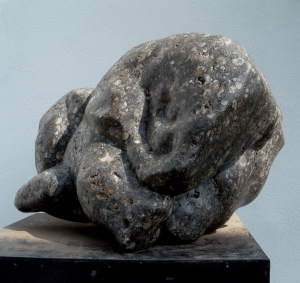 In the early 1800s, Petworth Marble rivalled many of the stones which were routinely imported from the continent, in both beauty and quality. A kind of shell marble occurring in the Wealden clay at Petworth, its quarrying was concentrated on the Egremont estate at Kirdford and there are accounts of industry at Plaistow.
In the early 1800s, Petworth Marble rivalled many of the stones which were routinely imported from the continent, in both beauty and quality. A kind of shell marble occurring in the Wealden clay at Petworth, its quarrying was concentrated on the Egremont estate at Kirdford and there are accounts of industry at Plaistow.
Also called Sussex marble, it was used in several chimney pieces at Petworth House and further afield at Westminster Abbey in Edward the Confessor’s Chapel, the tomb of Edward III and of Richard II and his Queen are both in “grey Petworth Marble” (The Saturday Magazine Supplement, May 1834 p.212); and Canterbury Cathedral, where the archbishops chair is an entire piece of the stone. (Useful Knowledge: Or A Familiar Account of the Various Productions of Nature: Animal, Vegetable and Mineral which are chiefly employed for the use of Man (1821) Volume I, William Bingley)
Winkles’s Architectural and Picturesque Illustrations of the Cathedral Churches of England and Wales Volume II (1851) documents embellishment of the Nave of Chichester Cathedral in both Purbeck and Petworth marbles, the latter making up pillars of the upper triforium which then showed some decomposition of the shelly particles.
These facts are now little known, but they are interesting to me as a sculptor having returned to my native West Sussex. I was intent on sourcing interesting local stones to carve; Fittleworth ironstone is harder than granite whilst Horsham stone looked promising but isn’t pleasant to work.
Back in 2008, I asked around as to anyone who might know of any source of the stone. New work produced after some 200 year gap would be a fine outcome! Courtesy of information from the Parish Council in Plaistow, I was alerted to a seam of the rock that had been uncovered as part of new foundations at Sparrwood Farm. Some test blocks were transported and a number of sculptures have since developed. Noticing the difficulty with which it is worked, I was intrigued by the amount of Petworth Marble in Chichester Cathedral – in many of the pillars. In further conversation, it appears that much restoration of the Petworth Marble is now performed with Purbeck Marble, which has visibly smaller Winkle shells and a stronger more stable structure – very important in times when budgets must be agreed and met.
So how does it carve? Well, it doesn’t really carve easily. The white shells are calcified remains within the brown/black matrix which derive from primeval muds. Where the stone has laid down well – appropriately trampled by igunadons and such – it is a fine stone – but more often than not there is a distinct strata of good flattened material, with other layers being very soft and brittle. Some are glutinous and almost like Christmas pudding – complete with the mincemeat feel. So you can imagine the horror of working with a large block only to be confronted with an area that is patently not stone in the midst of your carving. Fine for a sculptor who works with the material – not so good for the stonemason who works up designs to order. But where it is good, it is remarkable – a depth of colour from white to browns and blacks with as much tonal range as a good photograph. It provides such a colourful surface that the forms need to be simple to ‘read’ well in sculpture.
Sadly, a large work is too impractical to start until a commission for a permanent indoor work presents itself. Like alabaster, its gleaming qualities are ruined by being outside, despite the stone being very hardy in the well calcified sections. Many vintage paving and tomb stones around the quarrying sites are found to be Petworth Marble on closer inspection – their shallow gleam lost over the centuries, but the winkles are still visible to the curious. Take a look at some of the old paving around your houses if you live in the area.
 A 2011 Petworth House exhibition featured four works in Petworth Marble (including the 2008 work pictured above) and portraits in terracotta, supported by oil paintings by painter Martin Paterson. He studied under Joan Souter-Robertson who was a pupil of André Lhote, associated with the Cubist Movement in Paris. She has maintained a strong influence on his work, which aims to recreate the random shapes and colours of nature in compositions of formal beauty.
A 2011 Petworth House exhibition featured four works in Petworth Marble (including the 2008 work pictured above) and portraits in terracotta, supported by oil paintings by painter Martin Paterson. He studied under Joan Souter-Robertson who was a pupil of André Lhote, associated with the Cubist Movement in Paris. She has maintained a strong influence on his work, which aims to recreate the random shapes and colours of nature in compositions of formal beauty.
You can read more about Petworth Marble in Roger Birch’s book: Sussex Stones – The Story of Horsham Stone and Sussex Marble, Roger Birch (2005) ISBN 978-0955125904
Exhibition: 17-21st September 2011
JON EDGAR & MARTIN PATERSON
Petworth Marble, Portraits and Paintings
Petworth House, West Sussex

Hi Jon
I am a retired geologist researching with Roger Birch a book on West Sussex building stones. Nice to see your work in Sussex Marble. The best stone will be unweathered material found at depth. It cab be obtained from stream beds in the area north of Petworth.